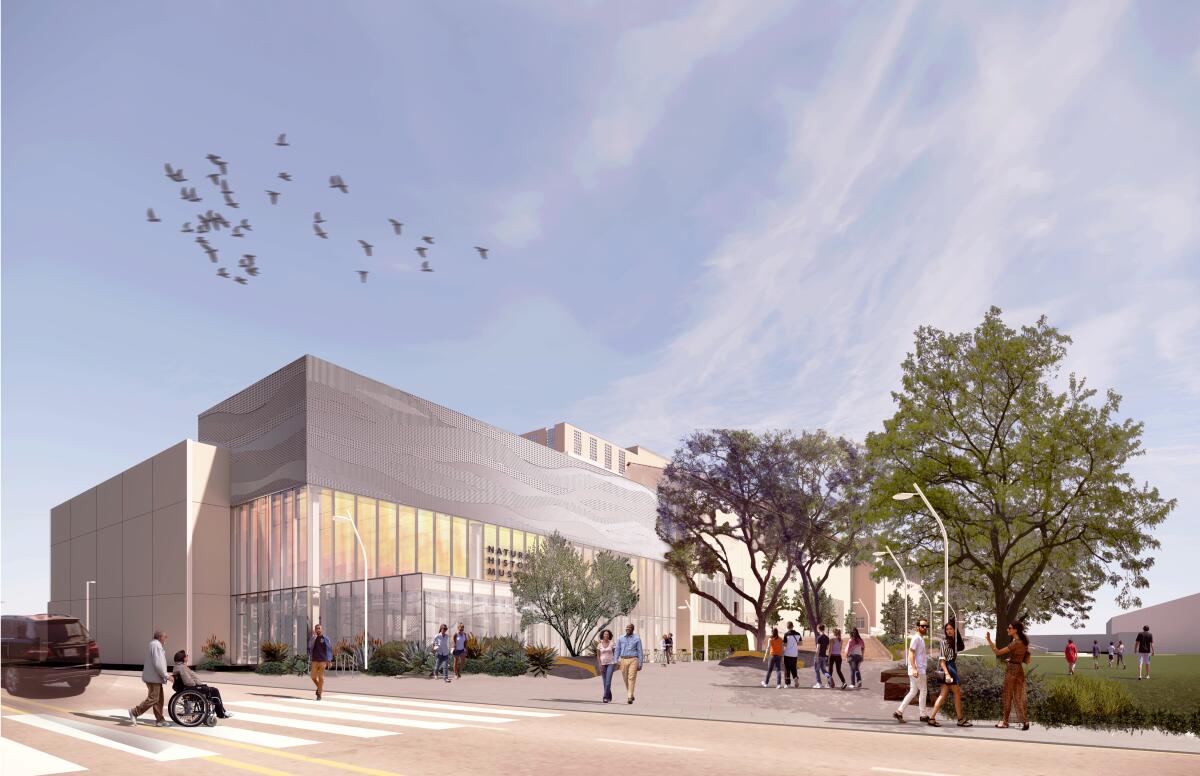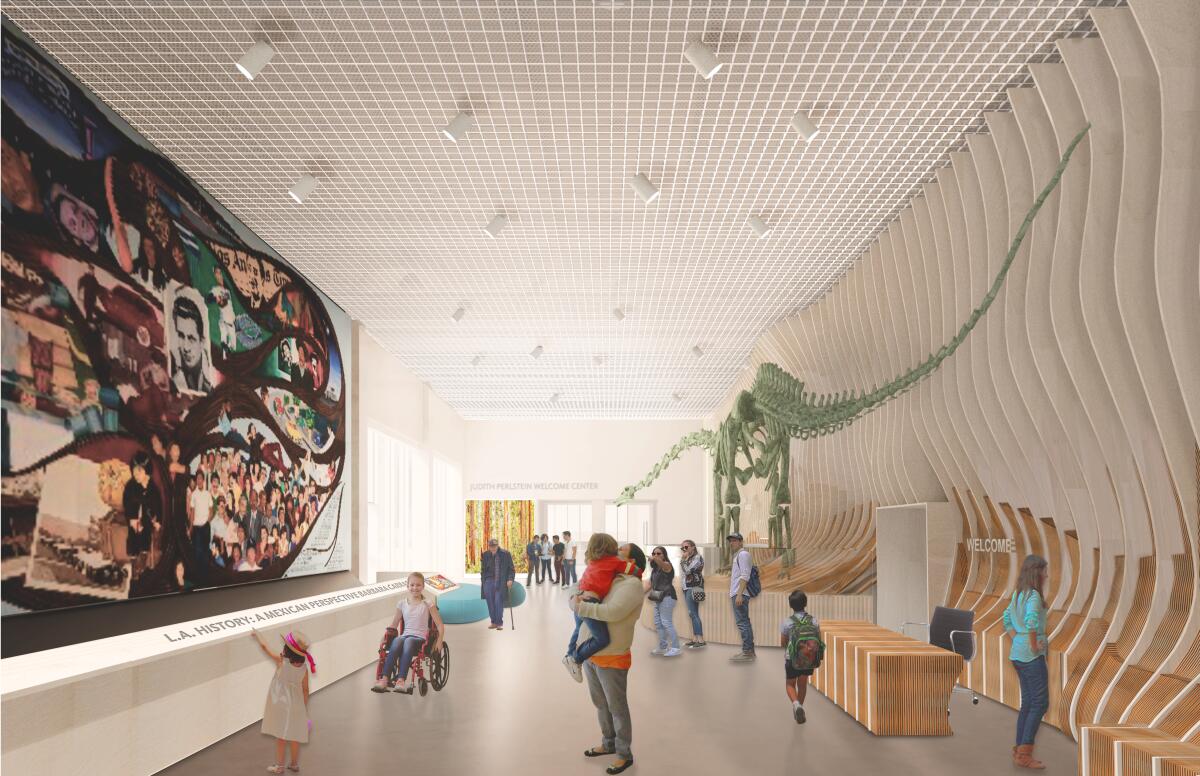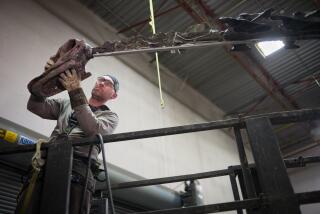The Natural History Museum’s major $75-million transformation set to open in 2024

The Natural History Museum of Los Angeles County’s $75-million transformation — a renovation and expansion project called the NHM Commons — is taking shape. The museum announced major updates to the project, including a new indoor-outdoor wing that includes a new entrance on the southwest side of the museum. The debut is slated for 2024, a year later than initially planned.
The NHM Commons, designed by L.A. firm Frederick Fisher & Partners with landscape design by Mia Lehrer’s Studio-MLA, adds 60,000 square feet of space to the museum. About 54,000 square feet of that is new construction and landscape design; 6,000 square feet is renovated space. The project includes a plaza for events that’s adjacent to the new entrance, a Welcome Center, a multipurpose 400-seat theater and event space (which replaces the long-shuttered, 1960 Jean Delacour Auditorium and which has retractable seating to allow for flexibility), a second café on the ground level and a new gift shop. There also will be multiple outdoor gathering spaces, including a small amphitheater and 9,500 square feet of new, sustainable plantings.
“It’s the culmination of work we’ve been doing over the last five to six years strengthening our community partnerships, launching programs and elevating community voices,” Natural History Museum President and Director Lori Bettison-Varga says.
The project — both physically and conceptually — is meant to better connect the museum to the community. Toward that end, the new entrance, which faces Exposition Park’s south lawn and the L.A. Coliseum, is made of transparent glass, so activities inside will be visible to passersby. The adjacent outdoor plaza is meant to serve as a “front porch,” so to speak, welcoming visitors inside.
“The idea is that themes from the outdoors come indoors — it’s a continuum,” Bettison-Varga says. “To me, [the architecture] is the physical manifestation of our strategic framework goal to be of, for and with Los Angeles.”
Additionally, the museum has created two advisory groups to help steer its vision. The NHM Commons Native American Advisory Council will work with museum leadership and Studio-MLA on the plaza entry and surrounding landscaping with an eye toward honoring Native American communities and acknowledging the fact that Los Angeles is on Native land.
Its five members are Tima Lotah Link, a cultural educator and Chumash textile artist (Shmuwich Chumash); L. Frank Manriquez, an artist and activist (Tongva/Ajachmem/Rarámuri); archaeologist Desireé Reneé Martinez (Tongva, Ti’at Society); Mark Villasenor, Tribal Senator (Fernandeño Tataviam Band of Mission Indians); and Tongva Taraxat Paxaavxa Conservancy Land Return Coordinator Samantha Morales Johnson, a digital illustrator, animator and painter (Gabrieleno-Tongva Band of Mission Indians).
“The idea is to have a recognition of land that is much more meaningful to first nations in Los Angeles than just having a plaque on the wall,” Bettison-Varga says. “We really want there to be an acknowledgment that is meaningful to the communities here.”
The 11-member NHM Commons Advisory Coalition will help steer new public programming and community initiatives. Members include Self Help Graphics & Art Executive Director Betty Avila; Korean American Family Services Executive Director Katherine Yeom; and USC School of Dramatic Arts’ Paula Cizmar, the university’s Resident Playwright for Environmental Justice and professor of theater practice in dramatic writing.
“In order to ensure that the NHM Commons programming — and the overall work of the museum — does what it’s meant to do, we wanted to make sure that we had a coalition of advisors who were really deeply connected to community work,” Bettison-Varga says.
With so many community leaders involved, from so many different areas of L.A., Bettison-Varga says, the NHM Commons is, in a sense, “co-curated” by a range of community partners.
“We really are using this as an opportunity, in the space, to do much more in the way of co-curation with community partners,” Bettison-Varga says. “So trying to find that right mix of museum launched programs, co-curated programs and community programs in this incredible space.”

The NHM Commons’ initial opening date had been fall 2023, but as with so many construction projects, “COVID delays came into play,” Bettison-Varga says. After experiencing supply chain issues, labor shortages and sluggish permitting processes, the museum pushed its opening to 2024. It broke ground in August, completed demolition and has started steel infrastructural work. The topping out ceremony, in which the substructure’s final steel beam will be secured, is planned for May.
The cost of the project has gone up as well, largely due to inflation, Bettison-Varga says, from $60 million to $75 million. But fundraising is “strong,” she says. The museum’s “Opening New Doors Campaign,” for the NHM Commons as well as the museum’s programming and endowment, has passed the $100-million mark. Nearly $64 million of that is earmarked for building costs.
In March 2020, the Los Angeles County Board of Supervisors released $15 million to the museum for the project. It also greenlit an additional $15 million, which the museum received in December 2021. Lead donors are the Annenberg Foundation and the Perlstein family, each of which gifted the museum with $5 million; the Ahmanson Foundation and Rose Hills Foundation, each of which gave $2 million; and the Ralph M. Parsons Foundation, which gave $1 million.
The museum currently waives admission fees during select periods each week. But when the NHM Commons opens, several areas of the museum will be free to the public whenever the institution is open. That includes, not surprisingly, the café and gift shop, but also the Wallis Annenberg Lobby and the more than 5,000-square-foot Judith Perlstein Welcome Center, in a renovated former exhibition hall. The Welcome Center will include multiple exhibitions on view.
When it debuts, the Welcome Center will display “Gnatalie,” a rare, 70-foot-long, green-hued long-neck dinosaur skeleton. It’s the first real one of its kind ever shown on the West Coast, with about 80% of its bones non-replicas, and the first green dinosaur skeleton to be shown worldwide. Barbara Carrasco’s iconic mural, “L.A. History: A Mexican Perspective,” will also be on view there. A community exhibition wall, still in development, Bettison-Varga says, will provide “additional exhibitions and storytelling.”
Bettison-Varga views the 43-panel Carrasco work — which depicts Los Angeles’ history from prehistoric times through the city’s 1781 founding to its 1981 bicentennial — as a “communal mural” and the “Gnatalie” skeleton as a “community dinosaur.”
“Community” being the operative word.
“The philosophy isn’t ‘if we build it they will come,’” Bettison-Varga says. “The philosophy has been ‘we need to have these intentional relationships and make sure that when we build it, we have robust programming and partnerships that will engage people in the work that we do and in the way they want to be engaged.’ So that they feel a part of it.”
“What does it mean to be a Natural History Museum today?” she adds. “That very much is about being with community.”
More to Read
The biggest entertainment stories
Get our big stories about Hollywood, film, television, music, arts, culture and more right in your inbox as soon as they publish.
You may occasionally receive promotional content from the Los Angeles Times.











